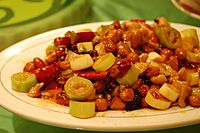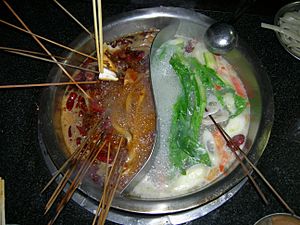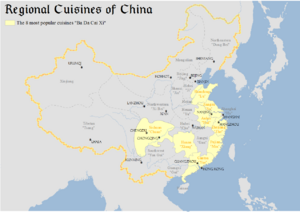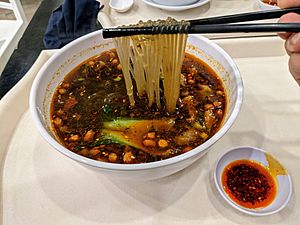Sichuan cuisine facts for kids
Quick facts for kids Sichuan cuisine |
|||||||
|---|---|---|---|---|---|---|---|

|
|||||||
| Chinese | 四川菜 | ||||||
|
|||||||
| Chuan cuisine | |||||||
| Chinese | 川菜 | ||||||
|
|||||||
Sichuan cuisine, also called Szechwan cuisine, is a popular style of Chinese cooking. It comes from Sichuan Province in China. This food is famous for its strong, bold tastes, especially its spiciness and a unique "numbing" feeling. These flavors come from using lots of garlic, chili peppers, and a special spice called Sichuan pepper.
Some well-known Sichuan dishes are Kung Pao chicken and Yuxiang shredded pork. There are many different ways to cook Sichuan food, even within Sichuan Province and the nearby Chongqing area. In 2011, UNESCO recognized Chengdu, the capital of Sichuan, as a "City of Gastronomy" because of its amazing cooking.
Contents
A Look at Sichuan Food History
Sichuan has always been a place where different foods and ideas mix. Long ago, in the Middle Ages, crops like broad beans, sesame, and walnuts came to Sichuan from the Middle East.
Later, around the 16th century, new foods arrived from the Americas. The most important one was the chili pepper from Mexico. This spicy pepper joined the traditional Sichuan peppercorn, which was already used. Other new foods included corn (which replaced millet), white potatoes, and sweet potatoes.
Sichuan is often called the "heavenly country" because it has so much food and natural resources. People in Sichuan love good flavors, especially hot and spicy ones. Even though many dishes are spicy, a typical meal often includes some milder foods to balance the taste.
Sichuan food uses seven main flavors: sour, pungent (strong), hot, sweet, bitter, aromatic (smelly), and salty. The mighty Yangtze River, China's longest river, flows through Sichuan. This river provides many basic food materials, spices, and water, which are all important for cooking.
What Makes Sichuan Food Special?

Sichuan Province has many different landscapes, like mountains, hills, and plains. This varied land means there are many different ingredients available for cooking.
The fertile Sichuan Basin grows lots of rice and vegetables. In the higher regions, you can find many herbs, mushrooms, and other fungi. Pork is the most common meat eaten. Beef is also used more in Sichuan than in other Chinese cuisines. Sichuan cooking also uses parts of animals like intestines, tongue, and liver. Rabbit meat is very popular here, much more than in other parts of China.
Sichuan cuisine often uses foods that have been preserved. This includes pickling, salting, and drying. These preserved dishes are usually served spicy, often with lots of chili oil.
The most unique and important spice in Sichuan food is the Sichuan pepper. This pepper has a strong, citrus-like smell. When you eat it, it creates a special "tingly-numbing" feeling in your mouth. Other common spices are garlic, chili peppers, ginger, and star anise.
Broad bean chili paste is another very important seasoning. It's a key ingredient in famous dishes like Mapo tofu and double-cooked pork. Sichuan cuisine is also known for creating several famous sauces and flavors used in Chinese cooking today. These include:
Other mixed flavors include hot and sour, five spices, ginger juice, mashed garlic, sweet and sour, and spice salt.
Sichuan chefs use more than 20 different cooking methods. Some common ones are stir frying, steaming, and braising.
Famous Sichuan Dishes
| English Name | Image | Traditional Chinese | Simplified Chinese | Pinyin | What it is |
|---|---|---|---|---|---|
| Ants climbing a tree | 螞蟻上樹 | 蚂蚁上树 | mǎyǐ shàng shù | This dish has small bits of ground meat clinging to noodles, which looks like ants climbing a tree. | |
| Bon bon chicken | 棒棒 | 棒棒鸡 | bàngbàng jī | Chicken mixed with a dark, nutty sesame sauce. It's named after the sound of cleavers hitting the chicken to shred it. | |
| Chili oil wontons | 紅油抄手 | 红油抄手 | hóng yóu chāoshǒu | Wontons (dumplings) served in spicy chili oil. | |
| Dandan noodles | 擔擔麵 | 担担面 | dàndàn miàn | These noodles were originally a street snack sold by people carrying them on poles. | |
| Fish with pickled mustard greens | 酸菜魚 | 酸菜鱼 | suān cài yú | Fish fillets cooked with sour pickled mustard greens. | |
| Hot and sour noodles | 酸辣麵, 酸辣粉 | 酸辣面, 酸辣粉 | suān là miàn, suān là fěn | A noodle dish that is both sour and spicy, often eaten for breakfast or as a street snack. | |
| Kung Pao chicken | 宮保雞丁 | 宫保鸡丁 | gōngbǎo jīdīng | A famous dish with chicken, peanuts, vegetables, and chili peppers. | |
| Mao xue wang | 毛血旺 | 毛血旺 | máo xuě wàng | A traditional dish from Chongqing made with pig's blood, tripe, and other meats, seasoned with chili and Sichuan peppercorn. | |
| Mapo doufu | 麻婆豆腐 | 麻婆豆腐 | mápó dòufǔ | Tofu in a spicy sauce, often with ground meat. Its name means "pockmarked Grandma Ma's tofu." | |
| Sliced beef/beef tripe/ox tongue in chili sauce | 夫妻肺片 | 夫妻肺片 | fūqī fèipiàn | Thinly sliced beef and beef organs served cold in a spicy chili sauce. Its name means "husband and wife lung pieces." | |
| Shredded pork in garlic sauce | 魚香肉絲 | 鱼香肉丝 | yúxiāng ròusī | Shredded pork cooked in a sauce that tastes like it has fish in it, even though it doesn't. | |
| Sichuan hotpot | 四川火鍋 | 四川火锅 | Sìchuān huǒguō | A boiling pot of spicy broth where you cook your own meats and vegetables. | |
| Stir-fried green beans | 乾煸四季豆 | 干煸四季豆 | gān biān sìjì dòu | Green beans stir-fried until slightly wrinkled, often with chili and garlic. | |
| Spicy deep-fried chicken | 辣子雞 | 辣子鸡 | làzǐjī | Small pieces of deep-fried chicken mixed with many dried chili peppers. | |
| Tea-smoked duck | 樟茶鴨 | 樟茶鸭 | zhāngchá yā | Duck that is smoked with tea leaves and camphor wood, then fried. | |
| Double-cooked pork | 回鍋肉 | 回锅肉 | huíguōròu | Pork that is first boiled, then sliced and stir-fried with vegetables and sauce. | |
| Water-cooked meat | 水煮肉 | 水煮肉 | shuǐzhǔ ròu | Meat (often fish or beef) cooked in a very spicy broth with lots of chili and Sichuan pepper. | |
| Eggplant in the style of fish | 魚香茄子 | 鱼香茄子 | yúxiāng qiézi | Steamed eggplant served in a sauce that tastes like it's used for cooking fish. | |
| Shredded chicken salad | 涼拌雞絲 | 凉拌鸡丝 | liáng bàn jī sī | Shredded chicken mixed with a spicy garlic sauce, served cold. | |
| Bo-bo chicken | 缽缽雞 | 钵钵鸡 | bǒbǒ jī | A cold dish where chicken and vegetables are served on wooden sticks in a spicy sauce. | |
| Mala duck tongue | 麻辣鴨舌 | 麻辣鸭舌 | málà yā shé | Duck tongues stir-fried with Sichuan pepper and chili. | |
| Stir-fried chicken kidney | 爆炒腰花 | 爆炒腰花 | bàochǎo yāo huā | Stir-fried chicken kidney with a spicy pickled pepper sauce. | |
| Sichuan signature barbecue | 川味燒烤 | 川味烧烤 | chuān wèi shāo kǎo | Barbecue seasoned with the unique Sichuan pepper. | |
| Leshan douhua | 樂山豆腐腦 | 乐山豆腐脑 | lèshān dòu fǔ nǎo | Soft tofu with a special sauce, originally from Leshan, Sichuan. |
See also
 In Spanish: Gastronomía de Sichuan para niños
In Spanish: Gastronomía de Sichuan para niños


























